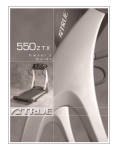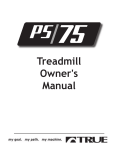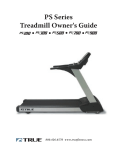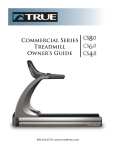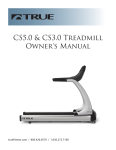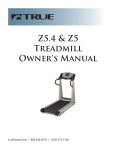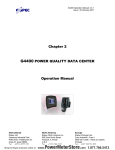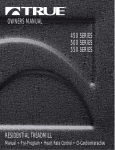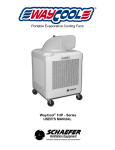Download True Fitness 400 Treadmill User Manual
Transcript
400 Series Owner’s Manual RESIDENTIAL TREADMILL Manual/Pre-Program/Heart Rate Control Thank You For Selecting A True Treadmill In 1981, Frank Trulaske launched True Fitness Technology, Inc. and began manufacturing hand-crafted treadmills. Intensive quality control standards guarantee excellence in every phase of production, resulting in the finest treadmills available in the Our original goal was to build the marketworld’s best treadmills, and today place. His team's obsession with quality we believe we’re doing it!” has -Frank Trulaske propelled True True to the treadmills top of the industry and has are consistently rated created one of America’s #1 for their smooth, oldest, largest and most quiet and comfortable respected treadmill performance. Today, manufacturers. True’s True is the choice for 200,000 square foot facility, workouts among just outside St. Louis, beginners, rehab Missouri, houses the patients and top manufacturing plant, athletes world-wide. engineering laboratory and testing facility. Over the years, True has designed, developed and fabricated new and cutting-edge components for their complete residential and commercial treadmill line, including innovative frame and suspension systems. NOTE: The serial number must remain intact for the warranty to remain valid. Please check your serial # ID to verify it has not been tampered with, removed or altered. Table of Contents Safety Instructions Setting Up Your Treadmill Assembly Treadbelt Adjustment Control Panel Functions Basic Treadmill Operation Quick Reference Operating Instr. Manual Operation Programmed Workouts User Programs Heart Rate Control (workouts) Cruise Control Important Points About Heart Rate Control The F.I.T. Formula Beginning Your Exercise Program Care and Maintenance Troubleshooting Guide Diagnostics 1-2 3-4 5-6 7-8 9 10-11 12 13 14-15 16 17-20 21-22 23-24 25-29 30-32 33-34 35 36-37 Safety Instructions Important Safety Instructions When using this treadmill, basic precautions should always be followed, including the following: Read all instructions before using this treadmill. Consult your physician before beginning any exercise program. Danger: To reduce the risk of electric shock, always unplug this treadmill immediately after use and before cleaning. Warning: to reduce the risk of burns, fire and electric shock and injury to persons: This treadmill should never be left unattended when plugged in. Unplug it from the outlet when not in use and before any service is performed. Close supervision is necessary when this treadmill is being used by or near children, invalids, or disabled persons. Use this treadmill only for its intended use as described in this manual. Do not use attachments not recommended by the manufacturer. Never operate this treadmill if it has a damaged power cord or plug, if it is not working properly, if it has been damaged or dropped, or if it has been submerged in water. In these cases, the treadmill should be examined by a qualified service technician. Use a dedicated 110 volt, alternating current (AC), 15 amp three-prong grounded outlet. 1 Safety Instructions Keep the power cord away from heated surfaces. Never drop or insert any object into any opening. To disconnect, turn the power switch to the OFF position, then remove the plug from the outlet. Do not allow animals on or near your treadmill. Make sure the power cord has enough slack to allow the treadmill to raise freely without being limited by the cord or caught in the incline rack. Do not run the power cord under treadmill. Use the treadmill indoors only. Never use your treadmill near water or while wet. Using the treadmill around a pool, hot tub or sauna will void the warranty. Do not operate where aerosol (spray) products are being used or where oxygen is being administered. Allow only trained personnel to service this equipment. Keep the area under the treadmill free from obstruction, as the deck will return to 0% grade when the safety key is placed on console. Avoid the possibility of bystanders being struck or caught between moving parts by making sure that they are out of reach of the treadmill while it is in motion. Keep the space behind and on both sides of the treadmill clear should you lose your balance. 2 Setting Up Your Treadmill Allow only one person at a time on your machine. Do not operate treadmill without the safety key attached to the console and the lanyard clipped to your clothing at approximately waist height. Always straddle the treadbelt and allow the belt to begin moving before stepping onto the belt. Use extreme caution when stepping onto moving tread belt. Some programs begin at speeds as high as 4.8 mph. Gradually slow down the belt before stopping. This will minimize the sensation of movement after you stop. When making treadbelt adjustments, keep fingers, loose clothing, jewelry, and long hair away from moving parts. Setting Up Your Treadmill Place your treadmill on a clean, level surface. Make sure the electrical cord easily reaches a grounded three-pronged outlet and has enough slack to allow the deck to incline without tightening the cord. Do not allow the treadmill assembly to rest on the cord. Although your treadmill is designed to operate on most carpeted surfaces, some deeply padded or heavy shag carpets can cause damage. To prevent damage to your treadmill or carpet, have someone stand on the deck and make sure the treadmill belt doesn’t touch the carpet at any point. Your treadmill is designed for indoor use only. Always keep the control panel out of direct sunlight. 3 Setting Up Your Treadmill Important Electrical Requirements Your True treadmill requires a dedicated 110 volt, alternating current (AC), 15 amp grounded outlet circuit. This means nothing else can be plugged into the same power circuit. Most household power circuits are rated for this 110VAC 15-amp requirement, but you must ensure the treadmill does not share the circuit with anything else. Danger: Do not use an extension cord or an ungrounded outlet. The ground helps prevent electrical damage to your treadmill and enhances your safety by preventing shock. Check with a qualified electrician or serviceman if you are in doubt as to whether the treadmill is properly grounded. Do not modify the plug provided with the treadmill – if it will not fit the outlet, have a proper outlet installed by a qualified electrician. A grounded outlet is critical for the Heart Rate Control system to function properly. 4 Assembly Assembly Hardware Kit: 1. Safety key 2. 5mm T-handle hex key 3. 5mm hex key/Philips screwdriver 4. 3mm hex key 5. 2mm hex key 6. 8mm x 15mm hex screws (4) 7. 8mm x 50mm hex screws (2) 8. 6mm x 15mm hex screws (4) 9. handrail clamps (2) Step 1: Carefully unpack treadmill and check that all hardware is present as shown. Step 2: Remove motor cover by taking out the six screws with Philips screwdriver. Step 3: The upper wiring harness is tucked into the bottom of the right pedestal leg. Lay the pedestal on the treadmill as shown on page 6. 5 Assembly Detach the rubber band from the upper wiring harness and route the cable down the pedestal leg support and out the bottom hole as shown. Step 4: Tilt the pedestal up and slide it down the pedestal supports, being careful not to pull out the upper wiring harness. Plug the upper wiring harness into the motor controller. Install the four 5mm x 15mm screws into the pedestal legs. 6 Treadbelt Adjustment Do not tighten any pedestal or handrail screws until instructed. Step 5: The proper side of each handrail is designated by a label. Install the handrails by sliding over the handrail stub next to the handlebar. Install two 2mm x 15mm screws at the top of each handrail. Install one 8mm x 50mm screw through the handrail clamp and into the bottom of the handrail as shown. Tighten all pedestal and handrail screws. Step 6: Reinstall the motor cover using the Philips screwdriver. Place the safety key on the circle labeled Safety Key on the console. Treadbelt Adjustment Your treadmill’s running belt has been properly aligned at the factory. However, when the treadmill is used on an uneven surface, please follow these instructions: 7 Treadbelt Adjustment 1. Stand beside the treadmill, place the safety key onto the control panel and follow operating instructions for running the treadmill at 5 mph. 2. If the belt is off-center to the right, turn the left roller adjustment bolt counter clock-wise 1/4 turn. If the belt is off-center to the left, turn the left roller adjustment bolt 1/4 turn clockwise. 3. Let the machine run for several minutes to check the alignment. (Belt alignment does not need to be perfect). If more correction is needed, turn the adjustment bolt 1/4 turn and check again. Treadbelt Tension To assure maximum life of the treadbelt, roller and drive motor, make sure the treadbelt tension is set correctly. (Your treadbelt has been properly tensioned at the factory.) Turn both rear roller adjustment bolts counter-clockwise until treadbelt just begins slipping when walking on it, then turn both rear roller adjustment bolts clockwise in equal quarter turn increments until treadbelt stops slipping. Note: Be sure to run on treadbelt to ensure that the treadbelt does not slip while under load. 8 9 Starts the belt in motion. Also resets workout data when held for 3 seconds. Start/Reset Removable magnetic key must be in place for treadmill to operate. Stop/Pause Stops the belt and pauses workout. If held for 5 seconds, resets all workout information. Grade Up/Down Adjusts incline. Also used to choose programs and to set distance in count down mode. Pace Time per mile at current speed. Adjusts speed in 0.1 mph increments. Also used to set weight and other workout parameters. Speed Slow/Fast Incline in percent grade Elapsed time. Can also Miles per hour in in 0.5% increments. be set to count down. 0.10 increments. Miles traveled in 0.1 mile increments up to 9.99 miles, or 0.10 mile increments past 10 miles. Can also be set to count down. Safety Key Grade Distance (400 HRC Shown) Time Speed Control Panel Functions Calories Accepts workout parameters, and toggles the dual function displays. Select/Enter Emergency expenditure rate. METS Estimated total calories burned. Basic Treadmill Operation Basic Treadmill Operation Starting Your Treadmill Safely Straddle the treadbelt by placing your feet on the straddle covers. Attach the lanyard to your clothing at about waist height. Place the safety key on the key holder on the console. Set your weight using the Press the keys and press . key for a quick start into a manual control workout, or press the key to begin setting up a different workout, as described in later sections. Stopping Your Treadmill Safely Slow the treadmill to below 2 mph using the Press key. . Setting Your Weight Your body weight must be entered so that the treadmill accurately estimates your calorie expenditure. This weight must include your workout clothing, too, which typically adds about three pounds. The treadmill will work fine without your weight setting, but will be unable to calculate your calories. When you are setting your weight, it is displayed in the Time Window. Your treadmill will remember the last weight you entered. 10 Basic Treadmill Operation A Note About Calorie Expenditure Calculations True treadmills use the calorie expenditure formula as described in Guidelines for Exercise Testing and Prescription from the American College of Sports Medicine. This is the most widely accepted formula for running and walking. Due to variations in human exercise efficiency, your actual calorie expenditure may vary by as much as 10% from the treadmill’s estimate. Monitoring Your Heart Rate (HRC model only) The 400HRC treadmill can monitor your heart rate when you wear the transmitter strap provided. It will display it as a digital beats-per-minute (bpm) readout, and it is very accurate, typically within two beats per minute. Your heart rate is good feedback on your effort level. See the Target Heart Rate chart on page 29 for more information. Although your treadmill functions fine without using the heart rate monitoring feature, this kind of monitoring gives you valuable feedback on your effort level. It also allows you to use the most advanced training system available on a treadmill: True’s Heart Rate Control, where the treadmill automatically adjusts your workout level based on your heart rate. See the Heart Rate Control section of this manual for details. Using the Heart Rate Transmitter Strap The transmitter strap should be worn directly against your skin, about one inch below the pectoral muscles/breast line. 11 Quick Reference Operating Instructions Women should be careful to place the transmitter below their bra line. Some moisture is necessary between the strap and your skin. Sweat from your exercise works best, but ordinary tap water may be used prior to your workout if desired. The Treadmill’s Heart Rate Display Before you start your workout, as you stand on or near the treadmill, you will know the treadmill is properly receiving your heart rate signal by the flashing heart-shaped “METS” LED beneath the Heart Rate window. Once you start your workout, your heart rate will be displayed in beats per minute. Quick Reference Operating Instructions For a Manually-Controlled Workout: Press for a Quick Start. The treadmill belt will start moving at 0.5 mph. Adjust Speed Using Keys Adjust Grade Using Keys To Use Pre-Set Programs: Set Your Weight Using Keys Press Scroll To Desired Program Using Keys 12 Manual Operation Set Program Level Using Keys Press Set Time Using Keys (15:00-99:00 Minutes) Press Manual Operation For a Quick Start, simply press . The treadmill belt will start moving at 0.5 mph. Note: Confirm that the body weight setting is correct as displayed in the Time window. If it is not, adjust it with the keys and press Adjust speed using . keys, and adjust grade using keys. To stop or pause your workout: slow machine to below 2 mph by pressing , then press . This will stop the treadmill and save your workout information. To restart your workout, press . To reset distance, time, and calories during your workout: Press and hold until zeros appear in the time, distance, calorie windows. To reset treadmill back to workout setup mode, press and hold 13 . Programmed Workouts Making Time and/or Distance Count Down instead of Up After adjusting your weight if necessary, press twice or until the lights in the time and distance windows flash. Press to set distance and to set time. When you press , time and distance will begin counting down. When the time or distance reaches zero, the treadbelt will continue to move and whichever readout reached zero (time or distance) will begin counting up. No other readouts will reset. Programmed Workouts Confirm that the body weight setting is correct as displayed in the center window. If it is not, adjust it with the keys. Press Press to select a program. Select a level using Press After program and level have been selected, set time using keys (15:00-99:00 minutes) Press to begin. 14 Programmed Workouts To stop or pause your workout: slow machine to below 2 mph by pressing then press . This will stop the program and save your workout information. To restart a program, press . To end your workout, press and remove the safety key. To reset distance, time, and calories during your workout: press and hold until the readout is reset. To reset treadmill back to workout setup mode, press and hold . To change level or program during workout: press and hold until program and level information shows in the Time window. Press keys to change level, change program, then press keys to . If a new program is selected, it will join that program at the same point as the previously selected program. Recall accumulated data (at end of work out) by pressing . Note: All workouts (programs) are able to be set from 15:00 99:00 minutes. Default value (if no time entered) is 30:00 minutes. When timer reaches 0:00 it will beep and begin counting up. You must press 15 to end your workout. User Programs User Programs During a manually-controlled workout, your 400 treadmill always "records" the changes you make in speed or incline. This recording can be saved as a User Program that you can "play back" to use as custom-designed workouts. Up to 50 changes in speed or incline can be recorded. Each speed/incline pair of changes must be separated by at least 30 seconds. To save a manual workout, press as you normally would to end your workout. Now press and hold until the display shows Save User 1. You can save your workout in User 1, or press User 2. Press to select and hold to save the workout program you have selected. To use a User Program that you have saved, simply select it from the list of programs as described in "Programmed Workouts" in the previous section. Heart Rate Control Workout True’s patented heart rate control workout allows you to limit both speed and grade for your safety and comfort. The treadmill adjusts both to keep you at your desired target heart rate, and it remembers these setup parameters for your next workout. Before selecting a target heart rate control workout, it is important to use the treadmill for several workouts in the manual mode while monitoring your heart rate. 16 Heart Rate Control Workout After you have spent some time learning how your heart responds to different levels of speed and grade, you will have a better understanding of how to select the maximum speed and maximum grade required to reach your target heart rate. Consult your physician to determine your target heart rate. See “Heart Rate Control Important Points” for some useful tips on using the HRC system. How the HRC system controls your heart rate: To raise your heart rate in the HRC mode, speed will always increase until maximum speed is attained, followed by grade (if grade is used in the workout). To lower heart rate in the HRC mode, grade will always decrease until zero grade is reached, followed by speed (if grade is used in the workout). Speed changes are in 0.1 mph increments. Grade changes are in 0.5% grade increments. This is equal to between 0.10 and 0.15 METs. NOTE: The heart rate control workout stores your workout parameters once you have completed an HRC workout. You do not need to enter all parameters each time you use the HRC workout. HRC Workout Setup After entering weight, press . Press scroll to the HRC workout, and press keys to . Adjust the target heart rate to your desired target using the , then press 17 . Heart Rate Control Workout Adjust maximum speed with the keys, then press . Adjust workout time with the keys, then press . (This does not include warm-up/cool down time.) Adjust maximum grade with the keys, then press . Press to begin your workout. Note: if you keep pressing , you will continue to scroll through the workout setup parameters. You can press at any time to accept the current parameters and begin your workout. Note: Hitting any other key will exit HRC mode. You can adjust your target heart rate at any time during your workout by pressing needed, and pressing , using the keys as again. If you are lowering your target, you are limited to a 5 bpm change. The Three Stages of a Heart Rate Control Workout 1. Warm-up Stage 2. Target Heart Rate Control Stage 3. Cool Down Stage 18 Heart Rate Control Workout Warm Up Stage Increase speed and grade gradually to slowly increase your heart rate to within 10 bpm of your target. For best results, you should take about five minutes to get to that point. The treadmill will operate in a manually-controlled mode during the warm-up stage. You control both speed and grade. You may only increase speed and grade to the preset maximum values entered. It is important that you start at a low level of perceived exertion and gradually increase your work load over several minutes until you approach your target heart rate. This allows your body to adapt to your workout. Increasing work load gradually will allow you to enter the heart rate control stage without overshooting your target. NOTE: Warming up too fast may cause you to overshoot your target. If this occurs it may take several minutes before the computer software can control your heart rate. You may overshoot and undershoot your target for several minutes until stable control is achieved. Heart Rate Control Stage When your heart rate is 10 beats away from your target, the computer software takes control of the treadmill at this point. The time window will reset and begin descending from the time you originally entered in the setup of the workout parameters. The treadmill’s computer now controls all speed and grade changes. The treadmill will gradually continue to increase your workload until you reach your selected target heart rate. Note: Do not touch any keys. Touching any key before pressing 19 first will immediately exit you from heart Heart Rate Control Workout rate control and begin your cool down stage. As your heart rate increases or decreases from your target, the treadmill will automatically make adjustments to speed and/or grade to keep your heart rate near your selected target. Cool Down Stage When time is elapsed and the HRC stage is completed, there will be an immediate 50% MET reduction in your work load. Your accumulated distance, calories, time and average heart rate will be displayed. The treadmill will now operate in the manual mode. The time will reset to 00:00 and begin to ascend. You will be in complete control of all speed and grade changes. It is recommended that you spend an equal amount of time in the cool down stage as you did in the warm up stage, or a minimum of at least two minutes. Press when you are finished. Note: Workout totals of time, distance, calories and average heart rate will appear in message at the end of your workout. If you prematurely press speed or grade to end your workout during the HRC stage, you will enter the cool down stage and your workload will remain constant. You may then manually adjust speed and grade. Note: Accumulated data of average heart rate, distance, calories, and time is displayed each time is pressed . 20 Cruise Control Cruise Control This is the simplest way to enter target heart rate training. While in manual or any program you can enter Target Heart Rate Control by simply pressing the key. For best results, you should be at least five minutes into your workout and warmed up. This will allow Cruise Control to more accurately control your heart rate. Remember, you must be wearing a chest strap and your heart rate should be displayed in the Heart Rate Window. To change your target heart rate press using and press . Edit the target . You can only edit 5 beats going down. Pressing will start a Heart Rate Control Program with the displayed valve as your target heart rate. How Cruise Control Determines How to Change Your Exercise Intensity If you enter the HRC stage below 5 mph, the speed you enter will be the maximum speed of your workout. i.e.: If you like to walk at a maximum speed of 3.8 mph, you should enter HRC at 3.8 mph. If you enter the HRC stage above 5 mph, you will have an additional 1 mph of speed. i.e.: If you enter HRC at 6 mph, your maximum attainable speed in the HRC stage will be 7 mph. If at any time you enter the HRC stage with grade, you will 21 Cruise Control have an additional 4% of grade available in the HRC stage. i.e.: If you enter the HRC stage at 1% grade your maximum attainable grade will be 5%. If you do not enter the HRC stage with grade, no grade will be available during the HRC stage of your workout. Only speed will be used to control your heart rate. Examples of Walking Workouts: 1. Enter HRC at 3.5 mph and 4% grade to allow a maximum speed of 3.5 mph and 8% grade. 2. Enter HRC at 4.2 mph and 6% grade to allow a maximum speed of 4.2 mph and 10% grade. Examples of Running Workouts: 1. Enter HRC at 6 mph and 0% grade to allow a maximum of 7 mph and 0% grade. 2. Enter HRC at 5 mph and 2% grade to allow a maximum of 6 mph and 6% grade. Examples of How HRC Can Work For You Example #1: A user who physically cannot walk over 2.5 mph can safely use heart rate control by entering maximum speed of 2.5 in a Heart Rate Control workout. Example #2: A runner can run up to a speed of 10 mph, without hills, by entering a maximum speed of 10 mph and a maximum grade of 0%. Example #3: A walker enters a maximum speed of 4.0 mph and a 22 Important Points About Heart Rate Control maximum grade of 6%. The walker is limited to a maximum speed of 4.0 mph and grade will be used if required to elevate the heart rate up to a maximum of 6%. Important Points About Heart Rate Control The Heart Rate Monitor transmitter strap provided with your treadmill should be worn directly against your skin at about one inch below the pectoral muscles/breast line. Women should be careful to place the transmitter below their bra line. Some moisture is necessary between the strap and your skin. Sweat from your exercise works best, but ordinary tap water may be used prior to your workout if desired. If the transmitter strap is adjusted or moved while exercising, communication may be temporarily affected. If communication is lost for 30 seconds, the treadmill will automatically shut off. The transmitter strap emits a fairly weak radio signal to the treadmill, so interference from other radio and sound waves (including everything from cordless telephones to loudspeakers) is possible. The good news is that interference is usually quite brief. If you continue to have intermittent heart rate display problems, consult your local service technician, as the transmitter strap batteries may be low. Make sure you breath smoothly and regularly. Talking during your workout usually causes heart rate spikes of 5 beats per minute or more, so avoid talking as much as possible. Maintain a smooth walking or running motion. 23 Important Points About Heart Rate Control A grounded outlet is critical for the HRC system to function properly. Use a dedicated 110 VAC, grounded outlet to help prevent interference. Two users wearing the same kind of transmitter at the same time and in close proximity may cause false heart rate display readings. Use only the transmitter provided with your True HRC Treadmill or a Polar brand standard transmitter. True’s Heart Rate Control is patented under USPTO #5,462,504. Heart Rate Control Safety Features If your heart rate exceeds your target by 12 beats, there will be a 30% MET reduction in workload to reduce your heart rate. If your heart rate exceeds your target by 20 beats, the unit will automatically shut off as a precautionary measure. (Be cautious when selecting your target heart rate so the 20 beat variance will not exceed your maximum heart rate as determined by your physician). How Target Heart Rate Works The user first sets their personal maximums for both speed and grade. This allows the user to customize and create a variety of workouts. By setting personal maximums for speed and grade, the user is provided safe workouts that fit their capabilities. Once this data is entered, along with target heart rate and workout time, the user is ready to start their Heart Rate Control workout. The initial stage of the Heart Rate Control workout is the warm-up stage and allows the user the flexibility to adjust 24 The F.I.T. Formula their speed or grade at anytime. The warm-up stage is not predetermined by the amount of time input prior to workout, and the user may take as much time as they wish to approach their target heart rate. The warm-up stage ends when the user’s heart rate is 10 beats below the pre-set target heart rate. At this point, the user enters the Heart Rate Control stage and the treadmill’s computer takes control of both the speed and grade (hands free). The treadmill software gradually increases the user’s heart rate to within 10 beats of the target heart rate. In the situation where workload needs to be increased in order to elevate the heart rate, the speed will be increased first in 1/10 mph increments. If needed, the speed will continue to increase up to the pre-set maximum. If the user still requires additional workload to raise the heart rate, the grade will be raised in .5% increments up to the maximum pre-set grade (unless zero grade was entered). Conversely, whenever the workload needs to be reduced in order to lower the heart rate, the grade will always be reduced first. The grade will be reduced to zero (if required), before speed is reduced. The F.I.T. Formula Understanding the F.I.T. Formula The workout portion of your exercise program consists of three major variables: Frequency, Intensity, and Time. 25 The F.I.T. Formula Frequency: How Often You Exercise You should exercise three to five times a week to improve your cardiovascular and FREQUENCY INTENSITY TIME muscle fitness. BEGINNING 2-3 days/week 60-65% of MHR* 3-5 minutes Improvements are EXERCISE minimal with less PROGRAM frequent exercise. ESTABLISHING 3-4 days/week 60-75% of MHR* 12-20 minutes Intensity: How Hard You Exercise AEROBIC FITNESS MAINTAINING AEROBIC FITNESS 4-6 days/week 70-85% of MHR* 20-30 minutes Intensity of exercise is *MHR = maximum heart rate reflected in your heart rate. Exercise must be sufficiently rigorous to strengthen your heart muscle and condition your cardiovascular system. Only your doctor can prescribe the target training heart range appropriate for your particular needs and physical condition. Start with exercise that stimulates you to breathe more deeply. Alternate periods of moderate and easy exercise to help your body adapt to new levels of exertion without unnecessary strain. If you are just beginning an exercise program, you may be most comfortable walking at a speed of 1-2 mph. As you use your treadmill regularly, higher speeds may be more comfortable and more effective. Inability to maintain a smooth, rhythmic motion suggests that your speed and/or elevation may be too great. If you feel out of breath before you have exercised 12 minutes, you are probably overdoing it. As your fitness level improves, you will need to increase your 26 The F.I.T. Formula workload in order to reach your target heart rate. The first increase may be necessary after two to four weeks of regular exercise. Never exceed your target heart rate zone. Increase the speed and/or incline on the treadmill to raise your heart rate to the level recommended by your doctor. The incline feature can be used to greatly increase the workload without increasing speed. The chart below indicates how much the effort changes with each percent of grade at popular speeds for a person weighing 155 pounds. METs One MET is the amount of energy your body uses when you’re resting. If a physical activity has an equivalent of 6 METs, its energy demands are 6 times that of your resting state. The MET is a useful measurement, because it accounts for differences in body weight. Time: How Long You Exercise Sustained exercise conditions your heart, lungs, and muscles. The longer you are able to sustain exercise within your target heart range, the greater the aerobic benefits. To begin, maintain two to three minutes of steady, rhythmic exercise and then check your heart rate. The initial goal for aerobic training is 12 continuous minutes. Increase your workout time approximately one or two minutes per week until you are able to maintain 20-30 continuous minutes at your training heart rate. Using the F.I.T. Formula The F.I.T. formula and chart are designed to help you begin a program tailored to your needs. You may wish to keep an 27 The F.I.T Forumula exercise log to monitor your progress. Treadmill Speed and Grade vs. METs Speed Grade 0 2 3 4 5 6 7 8 9 10 11 12 1 1.8 2.0 2.2 2.3 2.5 2.6 2.7 2.9 3.0 3.1 3.3 3.4 2 2.5 3.1 3.4 3.6 3.9 4.2 4.5 4.7 5.0 5.3 5.6 5.8 3 3.3 4.1 4.5 5.0 5.4 5.8 6.2 6.6 7.0 7.4 7.8 8.3 4 5.6 6.4 6.8 7.2 7.7 8.1 8.5 8.9 9.3 9.7 10.1 10.6 5 8.7 9.3 9.7 10.0 10.4 10.7 11.1 11.4 11.8 12.1 12.4 12.8 6 10.2 11.0 11.4 11.8 12.3 12.7 13.1 13.5 13.9 14.3 14.7 15.2 7 11.7 12.7 13.2 13.6 14.1 14.6 15.1 15.6 16.1 16.5 17.0 17.5 8 13.3 14.4 14.9 15.5 16.0 16.6 17.1 17.7 18.2 18.8 19.3 19.9 9 14.8 16.0 16.6 17.3 17.9 18.5 19.1 19.7 20.4 21.0 21.6 22.2 10 16.3 17.7 18.4 19.1 19.8 20.4 21.1 21.8 22.5 23.2 23.9 24.6 Note: Calorie expenditure rate is different for walking and running. True assumes you are walking if the treadmill speed is 3 mph or below, and running if the speed is 5 mph or higher. In between 3 and 5 mph, True doesn’t know if you are walking or running, so we use an in-between value. Your Fitness Program You can get valuable fitness benefits from your True Treadmill. Using the treadmill regularly may increase the ability of your heart and lungs to supply oxygen and nutrients to exercising muscles over an extended period of time. The treadmill will also help you develop added muscle endurance and balanced strength throughout your body. Determining Your Needs Calculate your maximum heart rate as a first step in developing your fitness program. The formula to calculate average maximum heart rate for one minute is 220 beats per 28 The F.I.T. Formula 100% 85% 75% INCREASED PERFORMANCE RANGE 60% AEROBIC TRAINING RANGE Heart Rate BPM WEIGHT LOSS TRAINING RANGE 20 25 30 35 40 45 50 55 60 65 AGE minute minus your age. To find your pulse, locate a vein on your neck or inside your wrist, then count beats for ten seconds, then multiply by six. (See chart above.) It’s also important to know your target training zone or target heart rate. The American Heart Association (AHA) defines target heart rate as 60-75 percent of your maximum heart rate. This is high enough to condition, but well within safe limits. The AHA recommends that you aim for the lower part of the target zone (60 percent) during the first few months of your exercise program. As you gradually progress you can increase your target to 75 percent. According to the AHA, “Exercise above 75 percent of the maximum heart rate may be too strenuous unless you are in excellent physical condition. Exercise below 60 percent gives your heart and lungs little conditioning.” In addition to monitoring your heart rate as you exercise, be certain of how quickly your heart rate recovers. If your heart rate is over 120 beats per minute five minutes after exercising, or is higher than normal the morning after exercising, your exertion may be too strenuous for your 29 Beginning Your Exercise Program current level of fitness. Reducing the intensity of your workout is recommended. The age-adjusted target heart rates indicated in the previous chart reflect averages. A variety of factors (including medication, emotional state, temperature, and other conditions) can affect the exercise heart rate appropriate for you. Warning: Consult your doctor to establish the exercise intensity (target heart rate zone) appropriate for your age and condition before beginning any exercise program. Beginning Your Exercise Program Warm-Up: Slow and Deliberate Exercise You are not warmed up until you begin to perspire lightly and breath more deeply. Warming up prepares your heart and other muscles for more intense exercise and helps you avoid premature exhaustion. Begin each workout by walking even if you plan to run. Start slowly, exploring different speeds until you can comfortably sustain your speed. A good suggestion is a minimum of three minutes. Perspiration on your brow is a good indicator of a thorough warm-up. The older you are, the longer your warm-up period should be. Workout: Brisk and Rhythmic Exercise The workout trains and conditions your heart, lungs, and muscles to operate more efficiently. Increase exercise in response to your heart rate to train and strengthen your cardiovascular system. Concentrate on moving your arms and legs smoothly. Walk naturally and avoid jerking motions that can cause pulled muscles, sprained joints, and loss of balance. 30 Beginning Your Exercise Program Cool-Down: Slow and Relaxed Exercise Cooling down relaxes your muscles and gradually lowers your heart rate. Slowly reduce your workload until your heart rate is below 60 percent of your maximum heart rate. The cool down should last at least five minutes, followed by some light stretching to enhance your flexibility. Beginning a Fitness Program If you cannot sustain 12 continuous minutes in your target heart rate zone, exercise several times a day to get into the habit of exercising. Try to reach and maintain 60-65 percent of your maximum heart rate. Alternate exercise with periods of rest until you can sustain 12 continuous minutes of exercise at 60-65 percent of your maximum heart rate. Begin exercising in three to five minute sessions. Establishing Aerobic Fitness If you can sustain 12 but not 20 continuous minutes of exercise in your target heart rate zone: Exercise three to five days a week. Rest at least two days per week. Try to reach and maintain 60-75 percent of your maximum heart rate with moderate rhythmic exercise. Begin with 12 continuous minutes. Increase your time by one to two minutes per week until you can sustain 20 continuous minutes. 31 Beginning Your Exercise Program Maintaining Aerobic Fitness If you can sustain 20 continuous minutes in your target heart rate zone, begin to increase the length and intensity of your workout: Exercise four to six days a week or on alternate days. Try to reach and maintain 70-85 percent of your maximum heart rate with moderate to somewhat hard exercise. Exercise for 20-30 minutes. Managing Weight Consistent aerobic exercise will help you change your body composition by lowering your percentage of body fat. If weight loss is a goal, combine an increase in the length of your workouts with a moderate decrease in caloric intake. For weight control, how long and how often you exercise is more important than how hard you exercise. Exercise four to five times a week. Try to reach and maintain 60-75 percent of your maximum heart rate with moderate exercise. Exercise for 30-45 minutes at 60-65 percent of your target heart rate. Here are some tips to achieving your weight management goal: Consume most of your dietary calories at breakfast and lunch, and eat a light dinner. Do not eat close to bedtime. Exercise before meals. Moderate exercise will help suppress 32 Care and Maintenance your appetite. Take exercise breaks throughout the day to help increase metabolism (calorie expenditure). Sports Training When you are training to improve strength and performance: Exercise four to five days a week. Alternate exercise days and intervals of hard to very hard exercise with easy to moderate exercise. Exercise for 30 minutes or longer. Warning These strategies are intended for average healthy adults. If you have pain or tightness in your chest, an irregular heartbeat, shortness of breath or if you feel faint or have any discomfort when you exercise, stop! Consult your physician before continuing. Remember, every workout should begin with a warm-up and finish with a cool-down. Care and Maintenance Your True treadmill is constructed of quality materials and manufactured to provide many years of faithful service. Simple routine cleaning and a preventive maintenance program will extend the life of your treadmill. NOTE: To prevent electrical shock, be certain the treadmill is turned off and unplugged from the electrical outlet before performing any cleaning or routine maintenance. 33 Care and Maintenance Treadbelt Lubrication With typical use (one user, 30 minutes a day), your treadmill does not require any lubrication. However, if it is used more frequently, it may require regular lubrication of the treadbelt. Please contact True Fitness for lubrication recommendations in these cases. Regular Cleaning Daily: Perspiration should be wiped from the control console and treadmill surfaces after your workout. Weekly: You should wipe down your treadmill once a week with a water dampened, soft cloth. Be careful not to get excessive moisture between the edge of the overlay panel and the console, as this might create an electrical hazard or cause the electronics to fail. Important: do not clean or wipe under the running belt. Monthly: Clean dust and dirt that might accumulate under and behind your treadmill once a month. Small rubber particles from the soles of walking shoes will accumulate alongside the belt and also behind the unit. Expert service and maintenance at a reasonable cost are available through your factory-trained, authorized True dealer. The dealer maintains a stock of repair and replacement parts and has the technical knowledge to meet your service needs. 34 Troubleshooting Guide SYMPTOM Circuit breaker on treadmill trips when the power cord is plugged into wall. CAUSE SOLUTION A. Damaged motor Service required B. Damage or defective motor power supply board Service required C. Damaged motor control circuit board Service required D. Restricted belt or flywheel Check and remove obstruction or call dealer E. Treadbelt over tensioned See adjustments Page 8 A. No power to treadmill Restore power at electrical outlet or reset circuit breaker if in “on/off” position. B. Circuit breaker trip Reset Circuit Breaker C. Upper wire harness not connected or completely connected. Service required Incline Motor and tread motor will not turn on A. Upper wire harness not connected or completely connected Service required Incline motor does not operate but the treadbelt moves A. Incline wire harness not connected Service required Scrambled digits on computer LED’s A. Damaged E-Prom Service required B. Damaged computer board Service required C. Upper wire harness partially connected Service required A. Poly V-belt slipping Service required B. Motor brush noise excessive Service required Circuit breaker on treadmill trips when inputting speed and starting. Computer display LED’s do not illuminate. Squeaking noise from motor while using the treadmill 35 Diagnostics SYMPTOM Treadbelt tracks left to right Treadmill trips household circuit breaker Treadbelt feels unsmooth, jerks intermittently CAUSE SOLUTION A. Uneven floor Move treadmill to even surface B. Rear roller not adjusted for sloped floor Refer to Owner’s Manual to adjust belt A. Defective breaker Replace breaker B. Circuit too small Use 20 amp circuit C. Circuit over-loaded Remove the other electrical appliances on same circuit A. Object between belt and deck Remove object between belt and deck B. Object under belt Remove object from under belt C. Loose tread motor drive belt Service required D. Loose treadbelt tension Refer to Owner’s Manual Diagnostics - Error Messages The following error messages will be displayed as they occur. Every time these messages are displayed, an audible will sound twice. E1:INCLINE Incline moving when not commanded to. E1:RANGE Difference between zero position and maximum incline not sufficient. 36 Diagnostics E1:STALL Incline not moving when commanded to. E2:OVERSPEED This error occurs when an acceleration >2.1 mph occurs. Error cleared by turning off power switch then turning it back on. E2:CAL Feedback cannot reduce or increase speed to target. Error cleared by calibrating. E3:RECAL This error occurs when a data error is detected on the EEprom, replace the control panel. E5:SENSOR This message is displayed when there is no speed feedback. Diagnostics - Service Messages The following service messages will be displayed as they occur, as well as for the subsequent six safety key insertions. These messages will be displayed until a key is pressed. Every time these messages are displayed, an audible will sound twice. S1:LUBE This message is displayed when lubrication of the deck is recommended. S2:CLEAN This message is displayed every 500 miles. Prompt to clean treadmill. S3:MOTOR This message is displayed every 2500 hours. Prompt to check motor brushes. 37 Founded 1981 865 Hoff Road O’Fallon, MO 63366 1-800-426-6570 www.truefitness.com ®2002 TRUE FITNESS TECHNOLOGY, INC. TRUE is a registered trademark of TRUE FITNESS Specifications subject to change Rev. 10/02









































